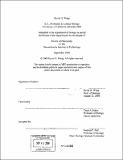Tuning strength and specificity in the N-end rule
Author(s)
Wang, Kevin H., Ph. D. Massachusetts Institute of Technology
DownloadFull printable version (16.19Mb)
Other Contributors
Massachusetts Institute of Technology. Dept. of Biology.
Advisor
Tania A. Baker.
Terms of use
Metadata
Show full item recordAbstract
Protein degradation is a central mechanism in the regulation of gene expression and activity. Proteolysis regulates not only homeostatic activities, but also the cell's responses to stress. A recurring question underlying this regulatory process is the specificity of substrate selection by the proteolytic machinery. I designed an unbiased selection to isolate N-terminal degradation sequences in vivo, which led to a collection of N-end rule signals. The N-end rule describes how the identity of a protein's N-terminal residue determines its metabolic stability. In E. coli, CIpAP is the principal protease that degrades proteins bearing an N-terminal phenylalanine, tyrosine, tryptophan, or leucine residue. The CIpS adaptor, which displays homology to eukaryotic ubiquitin ligases that recognize N-end signals, is a recently discovered component of the bacterial N-end rule. Using the collection of N-end signals, I was able to demonstrate that ClpS enhances N-end degradation by ClpAP but is not required in vivo or in vitro. The collection of N-end signals also provided insight into the role of sequence context in the N-end rule. Specifically, acidic residues and the length of the N-end signal affect degradation rates in vitro. These defective N-end signals also allowed us to separately define recognition specificities of ClpS and ClpAP. Whereas ClpS bound poorly to acidic N-end signals, CIpAP was unable to degrade substrates with short N-end sequences. Although two decades of biochemical and cellular data support the importance of the Nterminal residue in N-end degradation, there has been no structural information explaining how a single residue is recognized as a degradation signal. (cont.) To this end, we solved a cocrystal structure of CIpS in complex with an N-end peptide. CIpS uses an extensive hydrogen bonding network to dock the a-amino group and a cavity lined with hydrophobic residues to recognize the N-terminal residue. Furthermore, mutation of the hydrophobic cavity altered the specificity of CIpS toward N-terminal residues. Together these findings attribute molecular functions to CIpS and ClpAP in the bacterial N-end rule and define sequence rules for the N-end signal. Furthermore, this work provides the tools and background for investigating the mechanism of substrate delivery by ClpS to ClpAP.
Description
Thesis (Ph. D.)--Massachusetts Institute of Technology, Dept. of Biology, 2008. Title of thesis missing on title page; supplied from the abstract, p. [1]. Includes bibliographical references (p. 107-115).
Date issued
2008Department
Massachusetts Institute of Technology. Department of BiologyPublisher
Massachusetts Institute of Technology
Keywords
Biology.